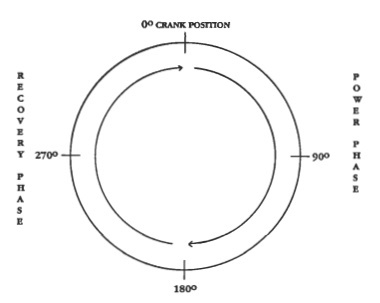Biomechanics of cycling
- Introduction
- Phases of cycling
- Factors affecting performance
- Pathomechanics
Introduction
Cycling is one of the common sports activity ranging from recreational to professionally competitive. Cycling provides linear progression of an individual. Cycling performance and style vary from person to person. Most important muscles working during cycling are the muscles of lower extremity and also trunk and upper extremity as well. Upper extremities provide stability while lower extremities produce power.
Phases of cycling
There are two phases of cycling: Power phase and Recovery phase

1. Power phase
Power phase is also called by some terms such as Downward phase, 0° to 180° and 12 to 6 'o' clock. Downward phase or power phase is again divided into two segments: 0° to 90° and 90° to 180°. During power phase, most of the power for cycle momentum is produced.
Muscle activity
- Gluteus maximus
Most active from 0° and relaxes at the level of 180° during power phase.
- Hamstring
It initiate activity from the middle of power phase and supports gluteus maximus for hip extension. After 180° hamstring becomes active part of knee flexion, continued till 270°. In simple words, hamstring works from middle of power phase to middle of recovery phase and quadriceps works during another half of middle phases.
- Quadriceps
It is active from 270° of recovery phase. During power phase, vastii group is more active during first segment of power phase (0° to 90°)
- Soleus and gastronemius
Soleus is more active during first segment of power phase and Gastronemius is more active from 90° of power phase.
2. Recovery phase
During recovery phase, force production is very less. It is continued from 180° to 360°. Like power phase, recovery phase also divided into two segments include 180° to 270° and 270° to 360°.
Muscle activity
- Hamstring
Active knee flexor during first segment (180° to 270°). Hamstring is assisted by gastronemius for knee flexion.
- Quadriceps
Rectus femoris initiates hip flexion during second half of recovery phase (after 270°). Followed by activation of vastus medialis and lateralis which help in knee extension. Quadriceps muscles are active till 90° of power phase.
-
Tibialis anterior
During knee flexion, there will be ankle dorsiflexion which is controlled by tibialis anterior. It is active till 0° or 360°.
Factors affecting performance
- Type of bike
- Seat height
- Type of handlebars
- Type of terrain
- level of experience
- Age
Pathomechanics
- Lowback pain
- Patellofemoral pain syndrome
SHARE:


- Peggy A. Houglum, Dolores B. Bertoti., Brunnstrom's clinical kinesiology (sixth edition).
- Cheryl A. Wozniak Timmer, MS, PT.,Cycling Biomechanics: A Literature Review (1991).
- Mandy Marsden, Martin Schwellnus., Lower back pain in cyclists: A review of epidemiology, pathomechanics and risk factors (2010).
| Name | : | Deva senathipathi |
| Qualifications | : | Physiotherapist |





